The DOE funding $42 million to support three hubs to develop inertial fusion.
The hubs will be led by researchers at Colorado State University, the University of Rochester, and Lawrence Livermore National Laboratory.
Projects funded by the program—known as Inertial Fusion Energy Science and Technology Accelerated Research (IFE-STAR)—will bring together expertise and capabilities across DOE’s National Laboratories, academia, and industry to advance IFE system components. Inertial confinement fusion is a leading approach to fusion that uses lasers or other technologies to compress and heat high-density plasmas. IFE-STAR projects will develop high-gain target designs; high-efficiency lasers at high repetition rates; and IFE-relevant fusion target manufacturing, tracking, and engagement. A major component of the funded projects is stewardship of the inertial fusion ecosystem, including the development of an inclusive and diverse workforce.
The members of the three hubs are:
Inertial Fusion Energy-Consortium on Laser-Plasma Interaction Research hub
University of Rochester (leader)
Ergodic LLC
University of California, Los Angeles
University of Nebraska–Lincoln
Xcimer Energy Corp.
Inertial Fusion Science and Technology hub
Colorado State University (leader)
Cornell University
General Atomics
Los Alamos National Laboratory
Marvel Fusion
SLAC National Accelerator Laboratory
Texas A&M University
U.S. Naval Research Laboratory
University of Illinois Urbana-Champaign
Xcimer Energy Corp.
National Science and Technology Accelerated Research for Fusion Innovation & Reactor Engineering hub
Lawrence Livermore National Laboratory (leader)
Focused Energy
Fraunhofer ILT
General Atomics
Leonardo Electronics US Inc.
Livermore Lab Foundation
Longview Fusion Energy
Massachusetts Institute of Technology
Oak Ridge National Laboratory
Savannah River National Laboratory
SLAC National Accelerator Laboratory
Texas A&M University
TRUMPF
University of California, Berkeley
University of California, Los Angeles
University of California, San Diego
University of Oklahoma
University of Rochester
Xcimer Energy Corp.
Lawrence Livermore National Lab – National Ignition Facility Roadmap
The National Ignition Facility (NIF) at Lawrence Livermore National Lab (LLNL) made worldwide news when they reached nuclear fusion ignition in December 2022 but they went beyond that result on July 30, 2023.
I am attending the 2023 International Conference on Inertial Fusion Sciences and Applications where there have been numerous presentations by leaders of the LLNL NIF team. I have also spoken with several of the speakers.
The Big 3 recent results were:
1. Aug 8, 2021 1.9 megajoules (MJ) of laser power was fired at a target which resulted in the release of 1.35 megajoules (0.72 return)
2. Dec 5, 2022 2.05 megajoules was fired at a target which resulted in the release of 3.15 megajoules (1.54X gain)
3. July 30, 2023 2.05 megajoules was fired at a target which resulted in the release of 3.88 megajoules (1.9X gain)

After Aug 8, 2021 there were several shots that did not reach a megajoule of returned power. There was a lot of work improving the targets and adjusting how the lasers were fired. The power of the entire system was increased by 8% from 1.9 MJ to 2.05 MJ. The quality of the targets had to be improved. They had to prevent three different major kinds of errors.
Keeping the system working at 2.05MJ or even 1.9MJ is difficult. The system is operating beyond its designed levels of 1.8MJ. The NIF system has damage that has to be repaired after shots are made.
There is software autotuning to calculate the adjustments to the laser pulse the target (holhraum).

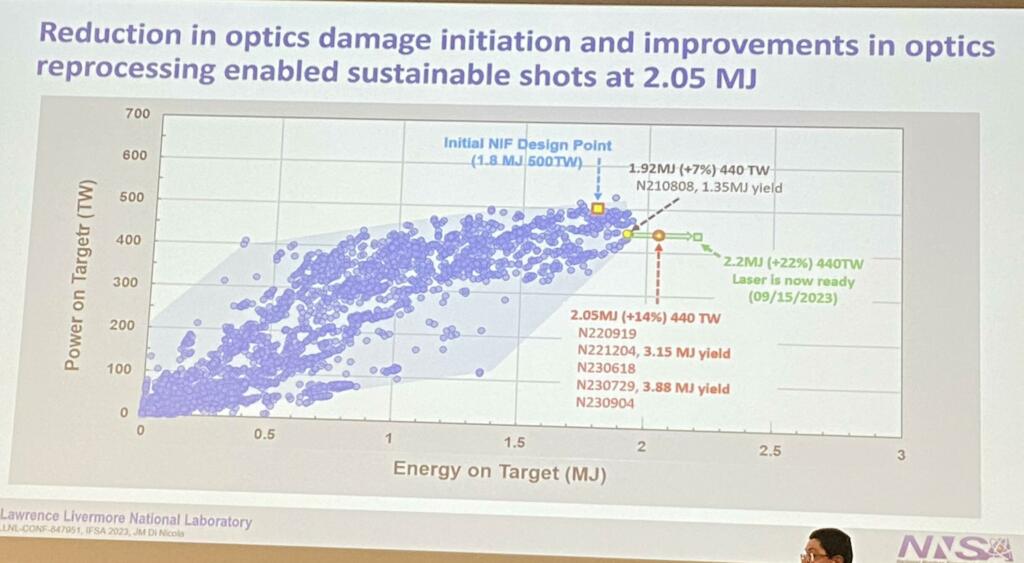
There are plans to increase the power to 3 MJ which would conservatively deliver more than a 10X gain and 30 MJ.
They have already prepared the NIF lasers and facility to operate with 2.2 MJ shots. The first 2.2 MJ shot are calculated to deliver 5-10 MJ. Modifying the target shape from a pill capsule like shape to one with a wide centerline with two stacked trapezoids (Frustraum) could deliver over 10 MJ using 2.2 MJ of laser power.

Tests have been made that indicate the current system could reach 2.6 MJ with fresh amplifier glass lens. NIF has bought and stored all of the original production of amplifier glass. The 2.6 MJ (and any midpoint between 2.2 MJ and 3MJ) has not been funded or approved. However, it would offer a lot of fusion bang for the buck to go to 2.6 MJ and then to make the modifications for 3 MJ. Timing and schedules are all highly uncertain but 2 years at 2.2MJ and then 2 years of testing at 2.6MJ makes sense to me. A
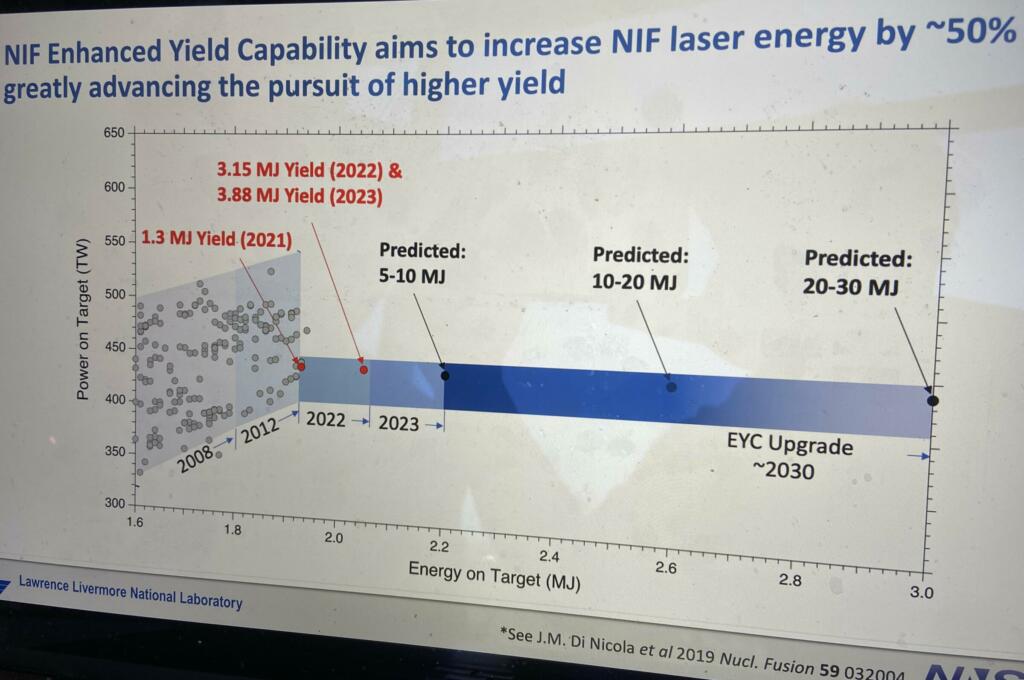


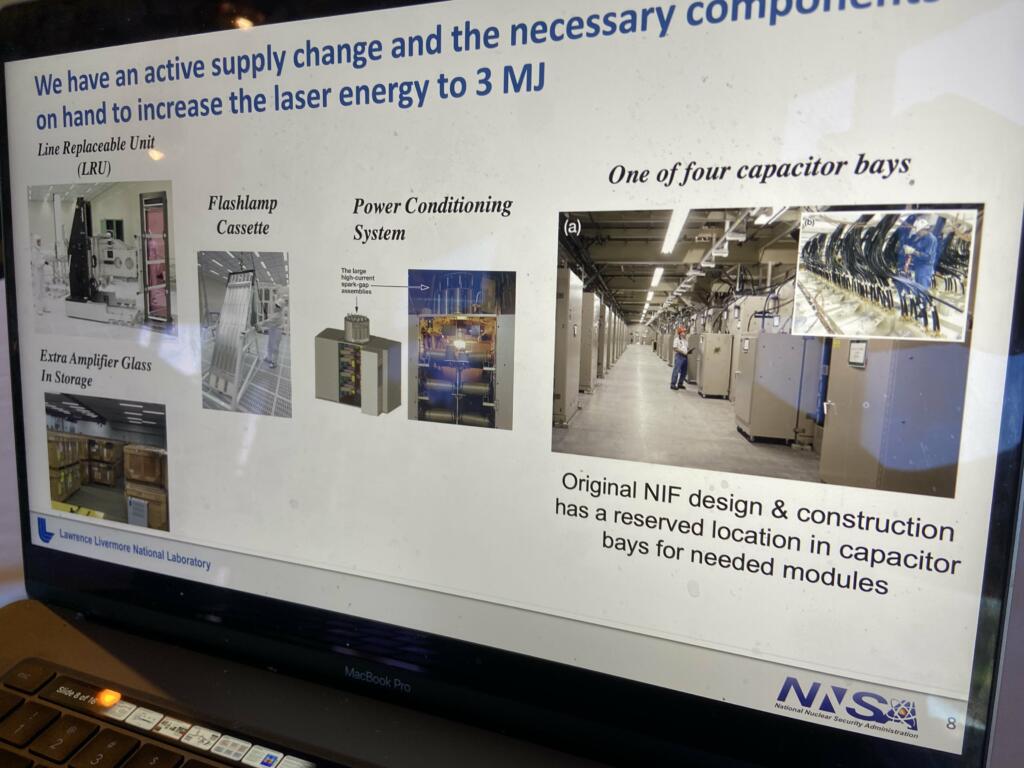

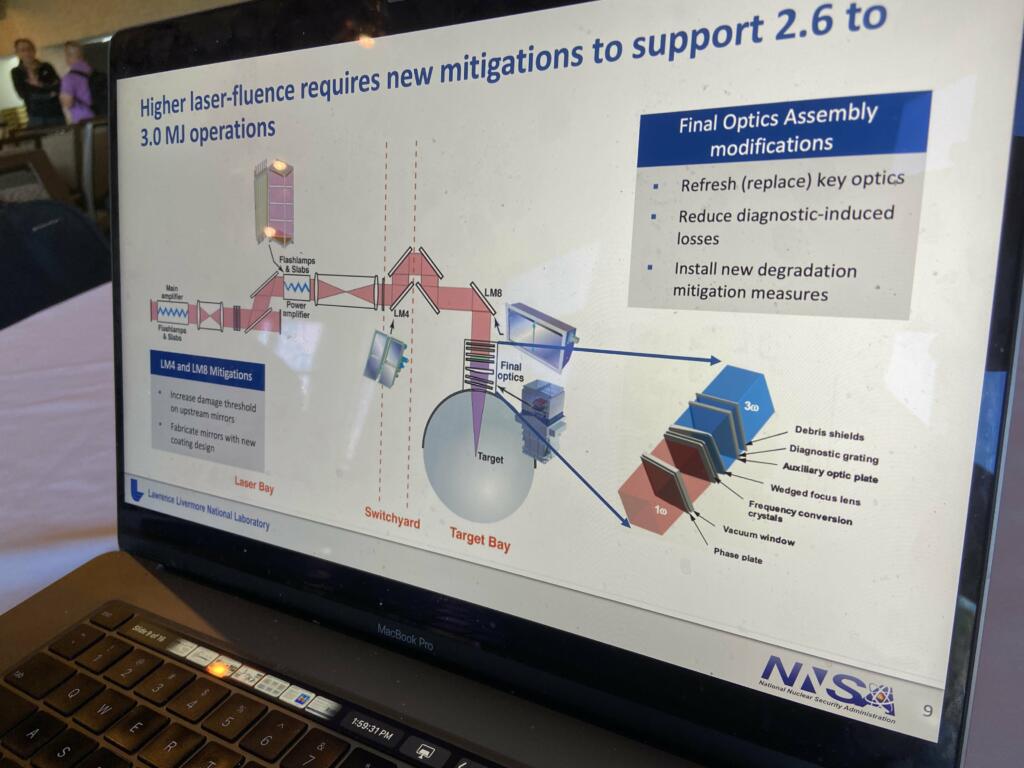
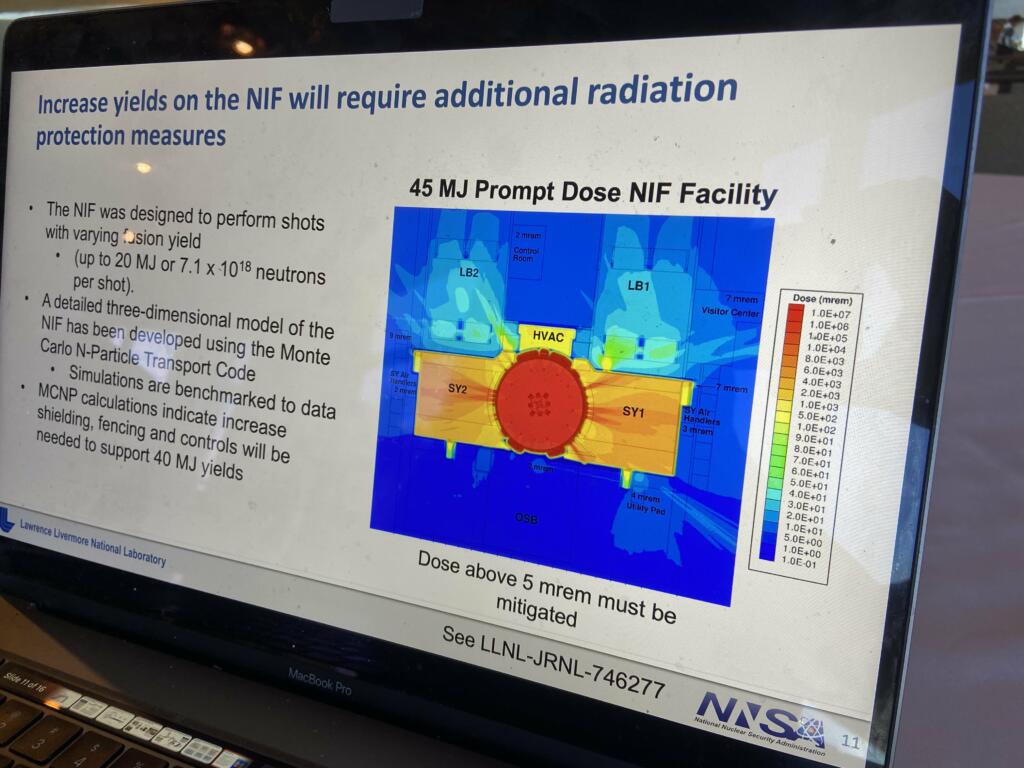
There is still selections and approvals to be made on how to perform higher power or high energy work.
The National Nuclear Security Administration (NNSA) makes the decisions about LLNL operations. Since its inception in 1952, LLNL’s defining responsibility has been national security — ensuring the safety, security and effectiveness of the nation’s nuclear stockpile. Nuclear Stockpile sustainment is still the main role.
LLNL’s mission has broadened in recent years, as dangers ranging from nuclear proliferation and terrorism to cyber-attacks and climate change increasingly threaten national security and global stability.
LLNL developing and proving that laser nuclear fusion is promising for potential commercial energy generation is greatly appreciated.
Future of NIF Laser Fusiom
I think that the campaigns to increase NIF power to 2.6 MJ and to 3 MJ makes a lot of sense.
It could also achieve 10-20MJ or more at 2.6MJ and 30+MJ with 3 MJ at NIF.
4-5X gain could be shown at 2.2MJ (2023-2025)
5-8X gain could be shown at 2.6MJ (est 2025-2027) and
over 10X gain could be shown at 3MJ (est around 2030).
The gain estimates could be very conservative if the science continues to improve targets. The target and other design plans are already being analyzed and prepared.
IF the improvements are as good as might be possible then 2.6 MJ could deliver 10-12X gain and 3MJ might give 20-30X gain. All of the estimates are theoretical. However, all of this would be years of hard work by hundreds of people. There have been many advancements and failed attempts. Ignition took ten years longer than was originally planned.
IF the results over-deliver designs and expectations, NIF cannot proceed past 120 MJ of returned power. There would be too much radiation and the facility would have to be completely changed.

Brian Wang is a Futurist Thought Leader and a popular Science blogger with 1 million readers per month. His blog Nextbigfuture.com is ranked #1 Science News Blog. It covers many disruptive technology and trends including Space, Robotics, Artificial Intelligence, Medicine, Anti-aging Biotechnology, and Nanotechnology.
Known for identifying cutting edge technologies, he is currently a Co-Founder of a startup and fundraiser for high potential early-stage companies. He is the Head of Research for Allocations for deep technology investments and an Angel Investor at Space Angels.
A frequent speaker at corporations, he has been a TEDx speaker, a Singularity University speaker and guest at numerous interviews for radio and podcasts. He is open to public speaking and advising engagements.


“ 1. Aug 8, 2021 1.9 megajoules (MJ) of laser power was fired at a target which resulted in the release of 1.35 megajoules (0.72 return)”
Is that true? I thought it was 1.9 MJ of X-ray energy absorbed by the fuel. Which came from much more laser energy hitting the hohlraum. Which came from even more laser energy being fired at the target.
So the 1.9 MJ is not the laser energy fired at the target. It’s only a small fraction of it.
Is that right?
(Also, MJ is “energy”, not “power”; power is just the speed at which the energy is flowing)
I’m fairly sure the UV through the final optics into the test chamber is about 2MJ/shot
To fund them is absolutely correct. So many money wasted elsewhere. They are not meant to do commercial fusion plant. They operate facility, which was designed 30+ years ago with some quite old tech and not primary for nuclear fusion.
After all the science and foundations they did, others need to build on that and use that to build commercial fusion plant with new, more efficient lasers and to design it for fusion.
They proved net gain, that is possible,… Modern lasers would be way more efficient and only a fraction of possible energy was relased. Fuel capsule has potential for way more fusion reactions that would give out way higher net gain.
That is a problem for non naysayers, who are willing to tackle this hard problem and find solutions to make it work. It is not quackery. It was proven it can be done.
The overall luminous efficiency of diodes is probably pretty topped out at 25% practically speaking… so there are some pretty low multipliers in the four or six factor formula for gain in a laser-driven fusion system, which is constantly reiterated by many technically astute people in the blogosphere. This gain function argument only becomes irrelevant with 50x, 100x, 1000x yields possible with staging or not… high yields are problematic for balance of plant design. The energy of a detonation would be hard to couple to a thermodynamic cycle on the human scale. Still, I think we should definitely blow things up with lasers. Duh.
As I understand they use about 1 percent efficient lasers, if modern ones are 20 perc efficient that would be nice improvement.
The second thing is how many fusion reactions form from capsule. I think a few percent of the fuel fused. Here we have a lot of room for improvement. If someone gets to 50 % of fuel fused and released energy, that would be great improvement.
If those 2 things are coupled, there will be orders of magnitude higher yields, that would be interesting for commercial usage.
I think they need to have more powerful shots, because then it is easier more fusion reactions to happen and they get more energy out, more fuel burns.
Now how much can be gained extra, if the laser bursts are more powerful, but also shorter(less total energy needed) and if they increase the size of the capsule to get even more out is another thing. I don’t know, I am not a fusion researcher.
The obvious fix is the LIFE reactor concept. Make a curtain of FLiBe salt inside the chamber and include actinides and TRU wastes in the salt. Fire a shot, make >90% of energy from fission, but still breed enough tritium to make things go around.
In fact, don’t bother with fusion; just do fission; that’s even better.
Gee … sounds like they’re almost ready to mass-produce these things and send abundant electricity to The Grid, right?
No? Mmmm… what’s the hold up?
Let’s see. Can’t run 2 shots milliseconds apart. The exploding hohlraum apparently blasts metals plasma and radioactive byproducts in all directions, making a rather fine mess out of the test chamber. So, one shot … clean up in a few days … and then another. Etcetera.
Can’t turn all that debris into a pulse of electrical energy. Its just a blast of plasma. Presently kind of a nuisance. Eventually, it has to have its kinetic and thermal energy captured and down-converted to electricity. This appears to be pretty FAR OFF the radar of the researchers.
Can’t mass-produce the (otherwise non-existent) plants into a compact, cost-effective unit. All the glib Rah-Rah-Rah notwithstanding, these things are one-offs, and dâhmned expensive one-offs at that. Billions per copy.
Apparently, can’t even scale the lasers without pushing the lasing elements themselves into permanent breakdown. Whenever I hear words like “fresh glass” and “they’ve stored all the previosly made lasing medium”, my skeptic-meter starts shooting up. So, this lasing medium degrades with each shot? That doesn’t sound very good. Just reading between the lines, of course.
________________________________________
Now, if the above were the only opinion, the obvious conclusion would be, “why the (fleep) are we wasting money with this research if the REAL WORLD prospects for it becoming a commercially viable energy production technology are so grim?” Right?
But the other side of me, the Old Physics Goat, also realizes that A WHOLE LOT of groundbreaking physics comes from long-term, high-expectation, mind-bogglingly expensive research. Or, so we have come to expect. The answers to the foundations of the Universe itself rest on the billions spent.
BUT THEY DON’T do anything practical, for the most part. No a single gizmo has come out of the billions spent on the Superconducting Supercollider. Or Large Hadron Collider. Or the International Thermal-Electric Reactor. None of it. LOTS of results, lots of papers, lots of PhD awarding publishing. Thousands — worldwide — of high Art physics careers made, professorships enjoined, physics departments funded, legions of PhD candidates educated and trotted forth.
Really though, scant practical results.
(Someone is going to pop up and say, but we wouldn’t have our ultra-nanometer scale chips today without the plasma deep UV light sources researched by these very same legions of physics PhD’s! Yes, this is so. There are good reasons to keep churning them out. I don’t deny it. )
Anyway, the pretty-as-you-please marketing of the strategic alliance of General Atomics, xCimer peoples, Lawrence Livermore black-hats and so on, is very impressive. A great way to gin up authorization for $42,000,000 investment dollars, which is … only $0.042 Billion in useful money. And everyone knows, it takes well over a billion to do any GREAT project in 2023.
⋅-⋅-⋅ Just saying, ⋅-⋅-⋅
⋅-=≡ GoatGuy ✓ ≡=-⋅
The usual “meh, not net gain; not scalable; etc.” comments…
It is a science project.
We spend $billions on pork – some flow charts show pork spending and money printing as the primary driver/input of the economy. We spend $trillions destroying countries and rebuilding them. NIF and some schools getting funding? That is ok.
Lets just watch the show, even if it isn’t going to revolutionize the way we live.
Every month we get practical results from NIF, I get their free magazine, Science and Technology,you should sign up for it.
Brian,great article,but you didn’t mention NIF’s other goal,which is basic science ,particularly, planetary science, where they examine conditions at the depths of gas giants.
Not all this funding is going to NIF. Not all the projects use hohlraums, or old lasers that have the practical issues you mention, or cost billions of dollars.
Shots need to be a lot more frequent but not a few milliseconds apart. Electricity extraction from DT can be a simple as coolant and turbine.
NIF is still useful for developing validated models of what it takes to ignite inertial confinement systems. That may (admittedly low probability compared to cheaper FRC schemes like Helion, Tri Alpha et al) lead to economically practical ICF schemes for energy, or future fusion propulsion.
Making a test chamber with lots of large and highly sensitive optical ports capable of withstanding 30MJ (equivalent to about 7kg high explosive) seems pretty hard to solve.
This all smacks of Big Science where funding is only funneled into projects that involve giant schemes.
And yet, now there are table-top particle accelerators.
I’d rather see funding allocated to smaller projects, like Lawrenceville Plasma Physics that represent a re-think of how to accomplish the same goals with substantially less cost and size. Companies like this could be funded with an amount of money represented by a rounding error of the funding provided for the Big Science projects.
This funding allocation is small. It amounts to less than the cost of a single Apache helicopter. Considering all the graft and waste that goes on in Warshington, this drop in the bucket gets my approval. What are they supposed to do? Put the body of work down after a bit success?